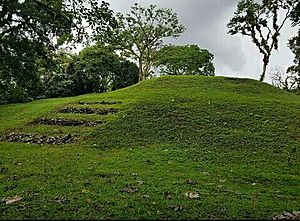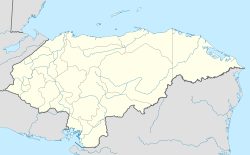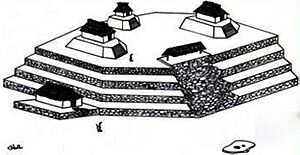Los Naranjos, Honduras facts for kids
Los Naranjos is an important ancient site in western Honduras. It is located right next to Lake Yojoa. This place helps us understand where the Maya frontier existed. It also shows how different ancient groups connected with each other. Scientists are still debating if the Maya people influenced those living near Lake Yojoa.
Contents
Discovering Ancient Los Naranjos
In 1935, two archaeologists, Frans Blom and Jens Yde, started digging at Los Naranjos. They explored a large mound and found many pieces of polychrome pottery. This means the pottery had many colors.
They believed the mound was a burial site. This is because the bowls and pots they found were carefully buried there. J.B. Edwards, a botanist, also helped them. He had already found many old items at the site.
Yde bought many of these items for the Danish National Museum. One special pot, called "the Yde Vessel," became very famous.
More Digs and Discoveries
From 1967 to 1969, archaeologists Claude F. Baudez and Pierre Becquelin continued the excavations. They wrote a book about their findings called Archeologie de Los Naranjos. It was written in French.
They found pieces of ceramic pots, called sherds, from four different time periods. This showed that people lived at Los Naranjos for a very long time.
The periods they identified were:
- Jaral (800–400 B.C.)
- Eden (divided into Eden I from 400–100 B.C. and Eden II from 100 B.C.–A.D. 550)
- Yojoa (A.D. 550-950)
- Rio Blanco (A.D. 950-1250)
They also found other cool items. These included small jade statues, clay pottery, and a jadeite hand axe. Many of these items looked like they came from the Olmec civilization.
The pottery found had different colors. Some were polychrome (many colors), some were monochrome (one color), and some were Ulua bichrome (two colors). Each type of pottery was popular during different time periods.
Layers of History
Archaeologists study stratigraphy. This is how layers of soil and artifacts show different time periods. The layers at Los Naranjos showed that people lived there for a very long time.
The oldest layers had simple, one-color pottery. Newer layers had more advanced, colorful pottery. Most of the pottery was made right there at Los Naranjos. Some might have been traded from other places.
Scientists used Radiocarbon dating on seven pottery pieces. This helped them figure out the exact dates for each period.
The Mysterious Yde Vessel
One clay pot found at Los Naranjos is very special. It is much larger and more decorated than other pottery from the site. The remaining part is about 24.4 centimeters (9.6 inches) tall. Its rim was about 23 centimeters (9 inches) across.
The pot is decorated in black and red, with an orange base. The designs show "dancing figures." This was a common art theme back then. The figures seem to be inside a cave.
Experts believe the cave setting is important. It might represent ideas about the first humans and how mankind began. Researchers Jesper Nielsen and James E. Brady think a crocodile-like figure on the pot is a god of fertility. This god might have been believed to watch over the start of humanity.
In their book The Couple in the Cave, Nielsen and Brady suggest something amazing. The people of Los Naranjos might have believed that Lake Yojoa and the Cave of Taulabé were where humans were born. For ancient Mesoamerican cultures, living near such a birthplace was very important.
Ancient Ditches
The site of Los Naranjos has two large ditches. One ditch stretched from Lake Yojoa to a pool. This was built during the Jaral phase. The second ditch was likely built during the Eden phase.
The reason for these ditches is still debated. Some think they were used for defense, like a protective barrier. Another idea is that they were filled with water. However, the ground at the bottom of the ditches seems too porous to hold water well.
The People of Los Naranjos
Los Naranjos is about 80 kilometers (50 miles) from where the Maya territories likely ended. It is thought that the people of Los Naranjos spoke Lenca. This is a language native to Honduras and El Salvador.
Today, the Lenca language is almost gone. But there are efforts to save and bring back the language. This is important for people of Lenca origin.
Baudez and Becquelin found signs of a structured society at Los Naranjos. They noticed that buried people had different kinds of items with them. Some had more advanced or valuable things. This suggested that there might have been a social hierarchy, or different levels of importance, among the people.
Connections with Other Cultures
The people of Los Naranjos had different connections with other ancient cultures over time. During the Jaral phase, their items showed links to the Olmec civilization. They found jade carvings and pottery pieces that looked Olmec. This suggests they might have traded with the Olmec.
During the Eden II phase, the pottery at Los Naranjos was not very similar to Maya pottery. It seems Los Naranjos might have been on the edge of the Maya and other Mesoamerican areas during this time.
However, in the Late Classic Period, things changed. Layers from this time showed that half of the pottery used by the people was related to the Maya. This Maya-style pottery was often polychrome, meaning it had many colors.
See also
 In Spanish: Los Naranjos (Honduras) para niños
In Spanish: Los Naranjos (Honduras) para niños




